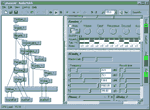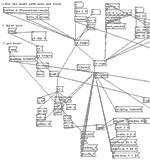AudioMulch
 AudioMulch
is an interactive musician's environment for computers. Bringing together
the popular with what has up to now been considered experimental,
AudioMulch wants to merge the worlds of mainstream electronica and
electroacoustic sound composition to create a fluid sonic environment.
While many of the processes featured within AudioMulch are not new
to computer music programs, it is the software's ability to carry
out these traditionally "studio" or "non-real-time"
signal processing techniques in real-time that emerges as its major
innovation. Through the essentially unlimited (only by the power of
the computer) combination of a network of synthesis and processing
contraptions, AudioMulch allows the users to extend their current
audio processing capabilities or create new music within their computer
without additional software or hardware systems. AudioMulch
is an interactive musician's environment for computers. Bringing together
the popular with what has up to now been considered experimental,
AudioMulch wants to merge the worlds of mainstream electronica and
electroacoustic sound composition to create a fluid sonic environment.
While many of the processes featured within AudioMulch are not new
to computer music programs, it is the software's ability to carry
out these traditionally "studio" or "non-real-time"
signal processing techniques in real-time that emerges as its major
innovation. Through the essentially unlimited (only by the power of
the computer) combination of a network of synthesis and processing
contraptions, AudioMulch allows the users to extend their current
audio processing capabilities or create new music within their computer
without additional software or hardware systems.
Audiomulch is a project by Ross Bencina, a composer and software developer
living near Melbourne, Australia.
http://www.audiomulch.com/
AudioRom
The creators of AudioRom are known for their experimental work exploring
and developing interactivity which pushes the boundaries of audience
participation. The distinguishing and innovative feature of their
work is the equal emphasis on music and visuals within the overall
form of the work.
Developing interactive multi-media installations and CD-ROMs, each
project defines a different formal approach to the fusion of visuals
and music through the use of various sensory interactive devices
and musical styles and samples. Interaction with music uses such
forms as typing or game playing or equipping the user with hundreds
of possible reconstructions while maintaining harmony and rhythm.
Explore the site and find your personal read-only-memory.
http://www.audiorom.com
Dissociated
Studio
 Dissociated
Studio is an attempt to do something similar for audio to what Dissociated
Press does for text (DP is a GNU command for scrambling a file of
text either word by word or character by character). Dissociated
Studio takes a piece of audio, segments it into 0.1 second segments
(by default), computes a matrix indicating how similar each segment
is to each other segment, and then plays the piece through, occasionally
skipping from one segment to another similar segment, while displaying
various either informative or spiffy-looking (or both!) displays. Dissociated
Studio is an attempt to do something similar for audio to what Dissociated
Press does for text (DP is a GNU command for scrambling a file of
text either word by word or character by character). Dissociated
Studio takes a piece of audio, segments it into 0.1 second segments
(by default), computes a matrix indicating how similar each segment
is to each other segment, and then plays the piece through, occasionally
skipping from one segment to another similar segment, while displaying
various either informative or spiffy-looking (or both!) displays.
Dissociated Studio is another project by Aaron S. Lav.
http://www.enteract.com/~asl2/music/dissoc_studio/
Fruityloops
Fruityloops is an easy-to-use loop and song creation tool on the
internet which allows even unskilled users to create wav, mp3 or
midi loops quickly after launching it. Fruityloops can play any
sample file (wav), generator (Fruityloops soft-synth), VST instrument
or midi instrument the users feed it. The photorealistic interface
of Fruityloops closely resembles existing electronic audio hardware
and makes the handling of the interface seem analogous to that of
real machines. The heart of Fruityloops, its step sequencer, can
be operated intuitively by simply clicking some dots, which allows
users to trigger sampler channels, control one of the generators
that come with Fruityloops or make any existing VST2.0 or DXi instrument
plugin scream.
Fruityloops is a product of the Belgian multimedia and program design
company Image-Line.
http://www.fruityloops.com
Infrasonic
Soundscape
As Hidekazu Minami, the designer of Infrasonic Soundscape, points
out, people in western societies are trained not to pay attention
to the ambient sounds surrounding them. This is why he articulates
them as instruments and as a "sonic geographical browser"
to provoke people to realize the importance of the infrasonic soundscape.
New York City with its unique architectural nature is the potential
sonic platform which provides him with low frequency sounds. With
samples of ambient city sound, he creates a sonar interface that
envelops users in the sounds of various geographical points of New
York City. Hence the users experiencing the interface are actively
involved in an unusual sonorous interaction. Minami's instruction
is to turn on the volume as loud as possible, set up stereo speakers
or headphones and LISTEN. Infrasonic Soundscape was first presented
in 2000.
Hidekazu Minami (MFA, Design and Technology, Parsons School of Designs)
is working in interactive design with motion and sound, visualization
in minimal design, articulated conceptual design, and architectural
understanding of space.
http://www.thejetty.org/thesis/
Lux
 Lux
is a discobased interface experience, best to be viewed in dark
rooms. Through a web-cam, the exhibition of five mirrorballs hanging
from the ceiling of a room is transmitted to the lux homepage and
is completed by another five virtual mirrorballs shown there. The
mirrorball being nothing but a visual accessory at dances now gains
supplementary function through its use as an online DJ-Interface,
representing a connecting element between situations and rooms.
The web page allows you to transmit sounds and songs to the mirrorballs.
Tracks saved onto the webcam-mirrorball can also be selected by
the exhibition's visitors. The visitor has to switch on the mirrorball
by pulling a string at the ball's bottom: as soon as the track has
been activated, the mirrorball rotates until the track is over.
Each mirrorball can save up to 10 songs/sounds. Lux
is a discobased interface experience, best to be viewed in dark
rooms. Through a web-cam, the exhibition of five mirrorballs hanging
from the ceiling of a room is transmitted to the lux homepage and
is completed by another five virtual mirrorballs shown there. The
mirrorball being nothing but a visual accessory at dances now gains
supplementary function through its use as an online DJ-Interface,
representing a connecting element between situations and rooms.
The web page allows you to transmit sounds and songs to the mirrorballs.
Tracks saved onto the webcam-mirrorball can also be selected by
the exhibition's visitors. The visitor has to switch on the mirrorball
by pulling a string at the ball's bottom: as soon as the track has
been activated, the mirrorball rotates until the track is over.
Each mirrorball can save up to 10 songs/sounds.
Lux is a poject by German artist Markus Bader. Bader visited the
Hochschule für Gestaltung Offenbach. Since then he has been
working with various designers and artists. A number of his projects
such as "Wipfelrauschen" were presented in exhibitions
in Germany(Frankfurt) and abroad.
http://www.natural-reality.de/lux/
Muse-O-Matic
Muse-O-Matic is an interactive music toy. You type in a word, and
algorithmic music is generated based on the letters of that word.
The letters are used in a completely deterministic way to control
the structure, rhythm, and melody of the music. You enter the word
- your name, for example - and select an algorithm. Algorithm A
generates more pleasant-sounding music, whereas algorithm B produces
more atonal results.
Muse-O-Matic is a project by US web musician Tim Thompson. He is
the composer of a collection of web-based algorithmic composition
toys, all of which make use of the KeyKit (formerly called Keynote),
a programming language for processing and producing MIDI music.
http://thompsonresidence.com/music/webtones.htm
http://thompsonresidence.com/music/matic.htm
Pd
 "Pd"
stands for "pure data". Pd is a real-time, open source
software system for live musical and multimedia performances. It
resembles the Max/MSP system but is much simpler and more portable;
also Pd has two features not (yet) showing up in Max/MSP: first,
via Mark Dank's GEM package, Pd can be used for simultaneous computer "Pd"
stands for "pure data". Pd is a real-time, open source
software system for live musical and multimedia performances. It
resembles the Max/MSP system but is much simpler and more portable;
also Pd has two features not (yet) showing up in Max/MSP: first,
via Mark Dank's GEM package, Pd can be used for simultaneous computer
animation and computer audio. Second, an experimental facility is
provided
for defining and accessing data structures.
It is in active development by Miller Puckette, and perhaps others.
The system is unfinished, but quite useable for sophisticated projects.
It has been ported to Linux, IRIX, and Windows NT. Due to the continually
evolving status of Pd, users working with the program at this stage
will need some patience and a sense of adventure. They might also
need to be comfortable compiling and debugging software written
for C and UNIX.
http://www.pure-data.org
Web Tones
Web Tones is a toy that converts an entire web page into music.
Users enter a URL, which can be anything ranging from HTML page
to image, sound file etc. - and have the possibility to control
nine different parameters of the track about to be produced such
as its scale, key, length and so on. The contents of the URL are
then used to generate simple algorithmic music.
Public Netbase's site in "c" is a rather funky waltz.
Try it.
Web Tones is another project by web musician Tim Thompson.
http://thompsonresidence.com/music/webtones.html
|

